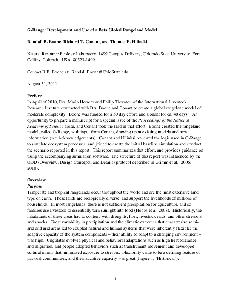agriculture
AGROVOC URI:
G-Range: development and use of a beta global rangeland model
In April of 2010, Drs. Mario Herrero and Philip Thornton of the International Livestock Research Institute contracted with Drs. Boone and Conant to create a global rangeland model of moderate complexity. Boone was funded for a 50 day effort, and Conant for ca. 40 days. An opportunity to prepare a manuscript for a special issue of the Proceedings of the National Academy of Science arose, and Conant took the lead in that effort. Boone created the rangeland model, called G-Range, with input from Conant, drawing upon existing models and new information (see Acknowledgements).
Groundwater availability and use in Sub-Saharan Africa: a review of 15 countries
Traditionally, the spread and extent of human settlement beyond the major riparian zones of Sub-Saharan Africa (SSA) and across many other arid regions of the world, has been determined by availability of groundwater supplies, accessed through hand-dug wells andsprings. In more recent times, groundwater is the preferred means of supplying water to meet the growing demand of the rural, dispersed communities and the small urban towns across SSA.
If we halt deforestation, will the world starve?
Making sure that we will continue to have enough to eat is at the heart of our shared ambitions to mitigate climate change. The United Nations Framework Convention on Climate Change (UNFCCC), the convention that has guided us through the highs and lows of 18 rounds of annual negotiations, states upfront that the reasons to stabilise emissions are threefold: to allow ecosystems to adapt naturally , to enable economic development to proceed in a sustainable manner and to ensure that food production is not threatened .
If we halt deforestation, will the world starve?
Making sure that we will continue to have enough to eat is at the heart of our shared ambitions to mitigate climate change. The United Nations Framework Convention on Climate Change (UNFCCC), the convention that has guided us through the highs and lows of 18 rounds of annual negotiations, states upfront that the reasons to stabilise emissions are threefold: to allow ecosystems to adapt naturally , to enable economic development to proceed in a sustainable manner and to ensure that food production is not threatened .
Introduction: the role of agricultural technologies in tropical deforestation
This introductory chapter sets the scene for the discussion in the edited volume on how new agricultural affects tropical forests. It critically reviews four hypotheses that have been central in the claim that better technologies help protect forests: the Borlaug, the subsistence, the economic development and the land degradation-deforestation hypotheses. Each of them appears to be valid only under certain restrictive conditions. The chapter then gives the aims and scope of the book, the key conclusions, as well as a summary of each of the chapters.
Investing in agricultural water management to benefit smallholder farmers in Zambia. AgWater Solutions Project country synthesis report.
This Working Paper summarizes research conducted as part of the AgWater Solutions Project in Zambia from 2009 to 2012. Approximately 48 million hectares (Mha) of land in Zambia are suitable for agricultural use. An estimated 67% of the Zambian labor force is employed in the agriculture sector. Researchers from the AgWater Solutions Project examined ways of improving the motor pump supply chain, how to make better use of small reservoirs and improving the function of horticultural markets. Researchers also explored gendered aspects of agricultural systems.
Land use and agricultural change dynamics in SAT watersheds of southern India
Impact of dynamic land use and land cover changes on the livelihood of local communities and ecosystem services is a major concern. This is particularly evident in most dryland agricultural systems in South Asia. We study land use/land cover (LULC) changes over the last two decades in a watershed (9589 ha) located in semi-arid eco-region in South India (Anantapuram district) using Landsat and IRS imagery. We captured additional data through field observations and focused group discussions.
Policy recommendations
This final chapter of the book offers a set of policy recommendations. It presents some typical win-win outcomes, including technologies suited for forest poor areas, labour intensive technologies promoting intensification to replace land extensive farming practices, and promoting agricultural systems that provide environmental services similar to those of natural forests.
Reducing deforestation and enhancing sustainability in commodity supply chains: interactions between governance interventions and cattle certification in Brazil
A large number of governance interventions are being developed in order to reduce deforestation and enhance the sustainability of commodity
supply chains across the tropics. The extent to which individual agricultural commodity supply chain interventions can achieve scale, and
environmental or social objectives, depends in part on the ways in which those interventions interact with other interventions. We use a casestudy
of the new Sustainable Agriculture Network (SAN) cattle certification program in Brazil to explore the different ways in which governance





